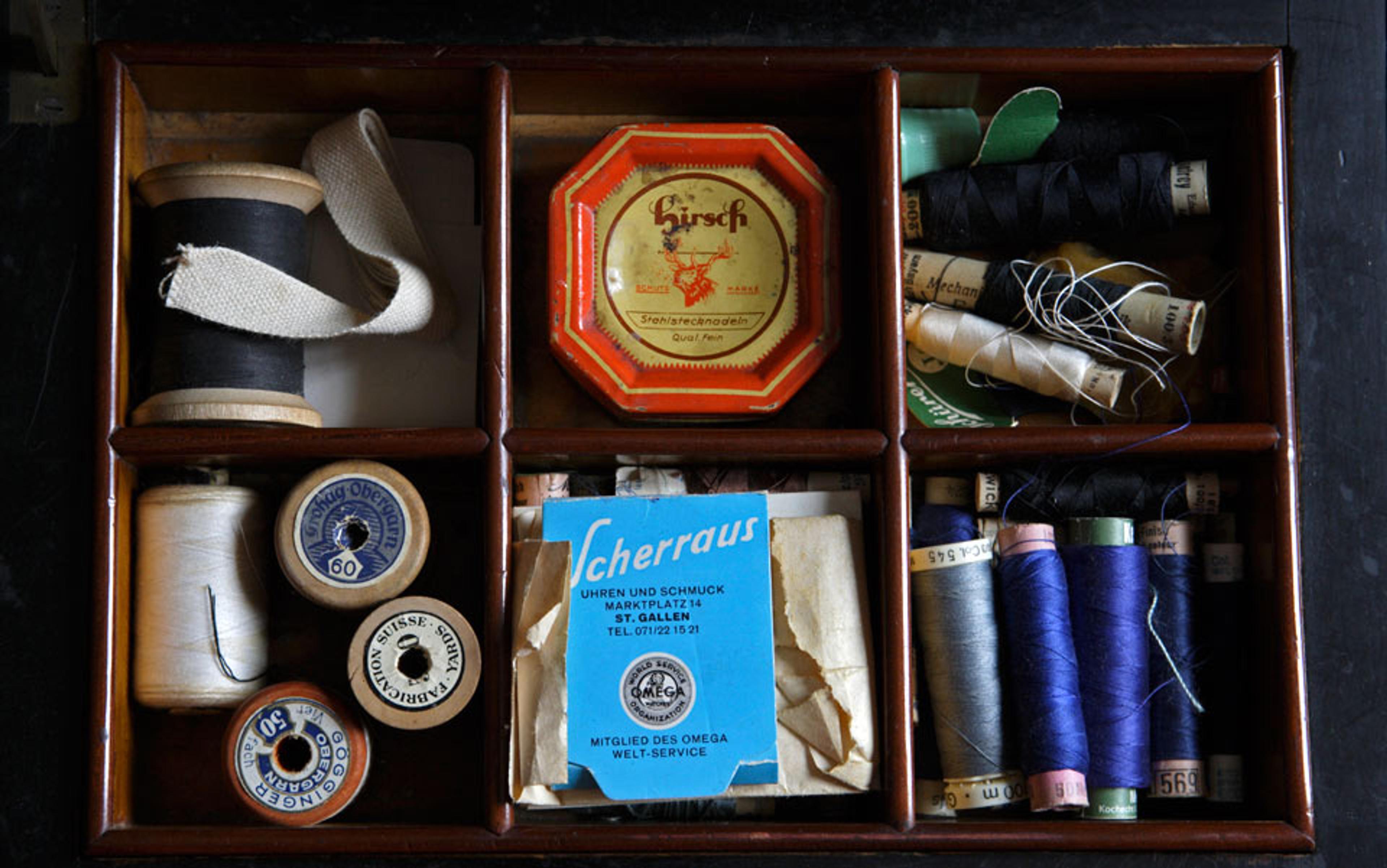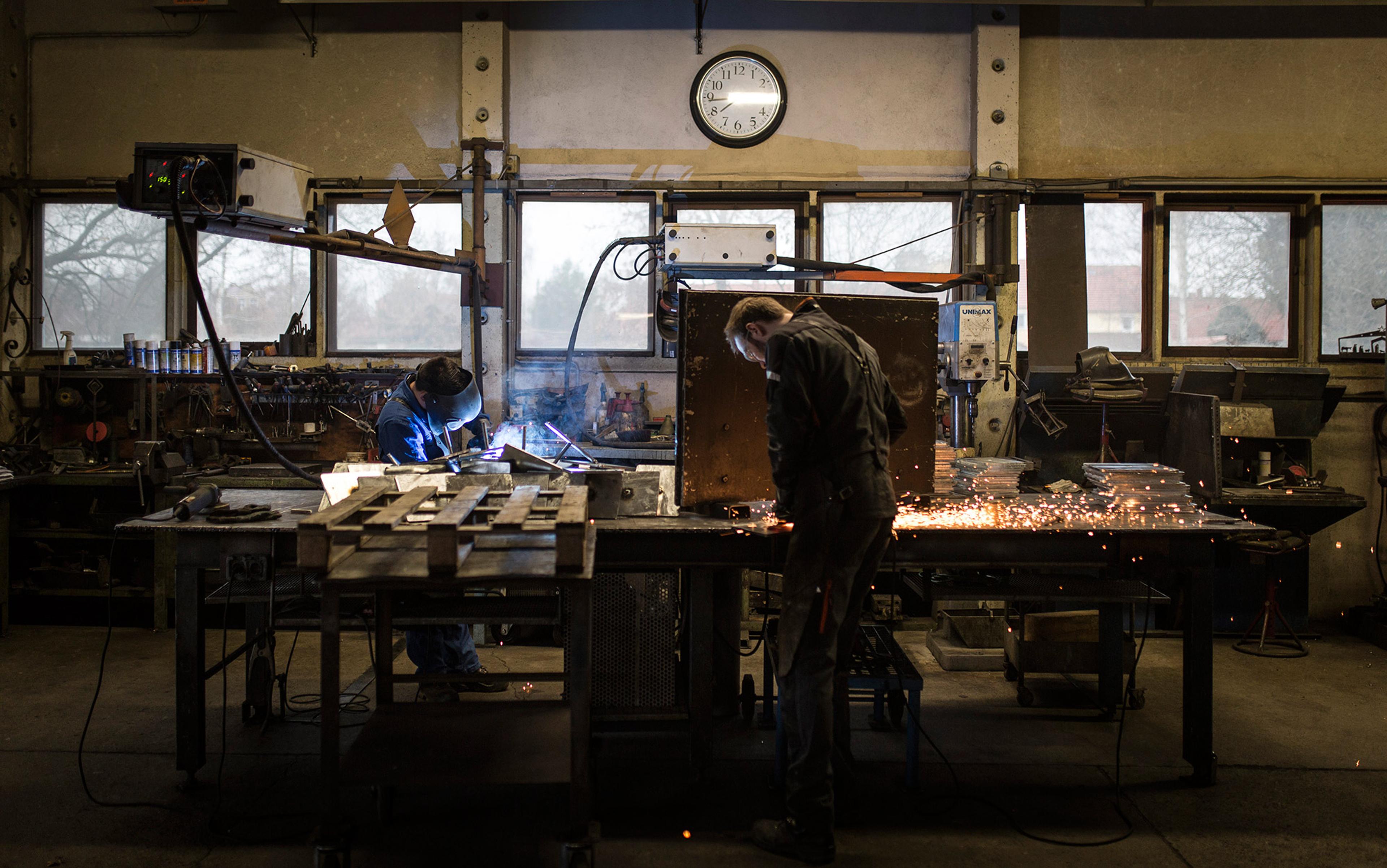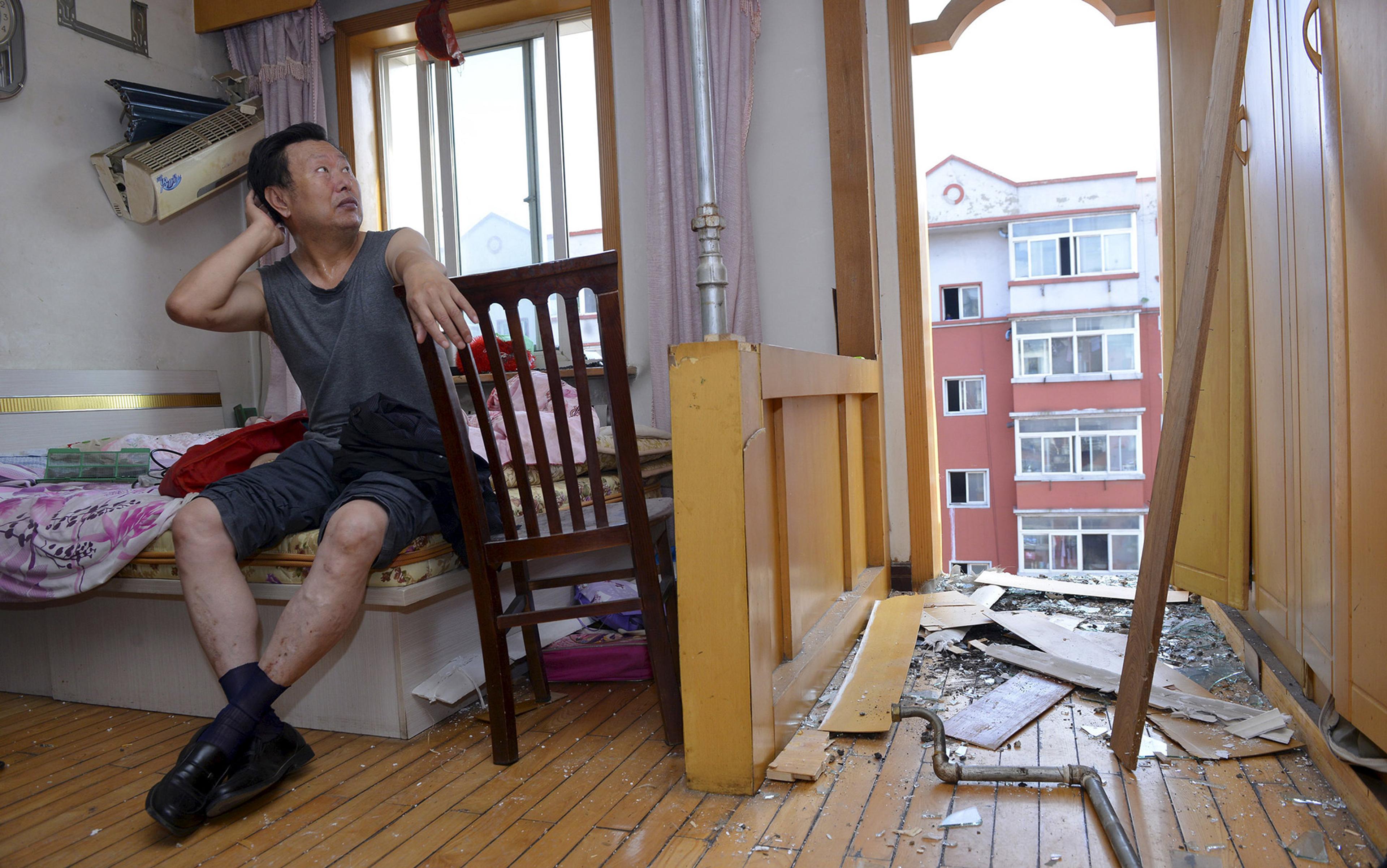The 16th-century Japanese tea master Sen no Rikyū is said to have ignored his host’s fine Song Dynasty Chinese tea jar until the owner smashed it in despair at his indifference. After the shards had been painstakingly reassembled by the man’s friends, Rikyū declared: ‘Now, the piece is magnificent.’ So it went in old Japan: when a treasured bowl fell to the floor, one didn’t just sigh and reach for the glue. The old item was gone, but its fracture created the opportunity to make a new one.
Smashed ceramics would be stuck back together with a strong adhesive made from lacquer and rice glue, the web of cracks emphasised with coloured lacquer. Sometimes the coating was mixed or sprinkled with powdered silver or gold and polished with silk so that the joins gleamed; a bowl or container repaired in this way would typically be valued more highly than the original. According to Christy Bartlett, a contemporary tea master based in San Francisco, it is this ‘gap between the vanity of pristine appearance and the fractured manifestation of mortal fate which deepens its appeal’. The mended object is special precisely because it was worth mending. The repair, like that of an old teddy bear, is a testament to the affection in which the object is held.
A similar principle was at work in the boro garments of the Japanese peasant and artisan classes, stitched together from scraps of cloth at a time when nothing went to waste. In boro clothing, the mends become the object. Some garments, like the fabled ship of Theseus, might eventually be overwhelmed by patches; others were assembled from scraps at the outset. In today’s trendy Tokyo markets, the technique risks becoming a mere ethnic pose. But boro was always an aesthetic idea as much as an imposition of hardship.
Although quite different in their social status, boro and the aesthetic of repaired ceramics alike draw on the Japanese tradition of wabi-sabi, a world view that acknowledges transience and imperfection. To mend a pot, one must accept whatever its fracture brings: one must aspire to mushin — literally ‘no mind’ — a state of detachment sought by both artists and warriors. As Bartlett explains in her essay ‘A Tearoom View of Mended Ceramics’ (2008): ‘Accidental fractures set in motion acts of repair that accept given circumstances and work within them to lead to an ultimately more profound appearance.’
Mended ceramics displayed their history — the pattern of fracture disclosing the specific forces and events that caused it. Indeed, earlier this year, a team of French physicists from the Aix-Marseille University demonstrated that the starlike cracks in broken glass plates capture a forensic record of the mechanics of the impact. By reassembling the pieces, that moment is preserved. The stories of how mended Japanese ceramics had been broken in the first place — like that of the jar initially spurned by Rikyū — would be perpetuated by constant retelling. In the tea ceremony these histories of the utensils provide raw materials for the stylised conversational puzzles that the host sets his guests.
For years, I have been patching clothes into a kind of makeshift, barely competent boro. Trousers in particular get colonised by patches that start at the knees and at the holes poked by keys around my pockets, spreading steadily across thighs with increasing disregard for colour matching. Only when patches need patches does the recycling bin beckon. At first I did this as a hangover from student privation. Later it became a token of ecological sensibility. Those changing motives carried implications for my appearance: the more defiantly visible the mend, the less it risks looking like mere penny-pinching. That’s a foolishly self-conscious consideration, of course, which is why the Japanese aesthetic of repair is potentially so liberating: there is nothing defensive about it.
This feels like rather a new idea in the pragmatic West. But things might be changing. Take, for example, the all-purpose mending putty called Sugru, an adhesive silicone polymer that you can hand-mould to shape and then leave overnight to set into a tough, flexible seal. As its website demonstrates, you can use Sugru for all those domestic repairs that are otherwise all but impossible, from cracked toilet seats to split shoes or the abraded insulation on your MacBook mains lead. (Doesn’t it always split where it enters the power brick? And isn’t it exorbitantly costly to replace?) Sugru was devised by Jane Ní Dhulchaointigh, an Irish design graduate at the Royal College of Art in London, working with a group of retired industrial chemists. Time magazine pronounced it a top invention of 2010, and it has since acquired an avid following of ‘hackers’ who relish its potential not just to repair off-the-shelf products, but also to modify them.
It wasn’t so much that things stopped working and then got repaired, but that repair was the means by which they worked at all
Sugru doesn’t do its job subtly, which is the point. You can get it in modest white, but fans tend to prefer the bright primary colours, giving their repairs maximal visibility. They present mending not as an unfortunate necessity to be carried out as quietly as possible but as an act worth celebrating.
A similar attitude is found in the burgeoning world of ‘radical knitting’. Take the textiles artist Celia Pym, who darns people’s clothes as a way of ‘briefly making contact with strangers’. There are no ‘invisible mends’ here: Pym introduces bold new colours and patterns, transforming rather than merely repairing the garments. What Pym and the Sugru crew are asserting is that mending has an aesthetic as well as a practical function. They say that if you’re going to mend, you might as well do it openly and beautifully.
Their approaches also reflect another of the aesthetic considerations of Japanese ceramic repairs: the notion of asobi, a kind of playful creativity introduced by the 16th-century tea master Furuta Oribe. Repairs that embody this principle tended to be more extrovert, even crude in their lively energy. When larger areas of damage had to be patched using pieces from a different broken object, one might plug the gap using fragments that have a totally different appearance, just as clothes today might be patched with exuberant contrasting colours or patterns. Of course, one can now buy new clothes patched this way — a mannered gesture, perhaps, but one anticipated in the way that Oribe would sometimes deliberately damage utensils so that they were not ‘too perfect’. This was less a Zen-like expression of impermanence than an exuberant relish of variety.
Such modern fashion statements aside, repair in the West has tended to be more a matter of grumbling and making do. But occasionally the aesthetic questions have been impossible to avoid. When the painting of an Old Master starts cracking and flaking off, what is the best way to make it good? Should we reverently pick up the flakes of paint and surreptitiously glue them back on again? Is it honest to display a Raphael held together with PVA glue? When Renaissance paint fades or discolours, should we touch it up to retain at least a semblance of what the artist intended, or surrender to wabi-sabi? It’s safe to assume that no conservator would ever have countenanced the ‘repair’ last year of the crumbling 19th-century fresco of Jesus in Zaragoza — Ecco Homo by Elías García Martínez — by an elderly churchgoer with the artistic skills of Mr Bean. But does even a skilled ‘retouching’ risk much the same hubris?
These questions are difficult because aesthetic considerations pull against concerns about authenticity. Who wants to look at a fresco if only half of it is still on the wall? Victorian conservators were rather cavalier in their solutions, often deciding it was better to have a retouched Old Master than none at all. In an age that would happily render Titian’s tones more ‘acceptable’ with muddy brown varnish, that was hardly surprising. But today’s conservators mostly recoil at the idea of painting over damage in old works, although they will permit some delicate ‘inpainting’ that fills cracks without covering any of the original paint. Cosimo Tura’s Allegorical Figure (c. 1455) in the National Gallery in London was repaired this way in the 1980s. Where damage is extensive, it is now common to apply treatments that prevent further decay but leave the existing damage visible.
Such rarefied instances aside, the prejudice against repair as an embarrassing sign of poverty or thrift is surely a product of the age of consumerism. Mending clothes was once routine for every stratum of society. British aristocrats were unabashed at their elbow patches — in truth more prevention than cure, since they protected shooting jackets from wear caused by the shotgun butt. Everything got mended, and mending was a trade.
What sort of trade? Highly skilled, perhaps, but manual, consigning it to a low status in a culture that has always been shaped by the ancient Greek preference for thinking over doing (this is one way in which the West differs from the East). Over the course of the 19th century, the ‘pure’ theorist gained ascendancy over the ‘applied’ scientist (or worse still, the engineer); likewise, the professional engineer could at least pull rank on the maintenance man: he was a creator and innovator, not a chap with oily rag and tools. ‘Although central to our relationship with things,’ writes the historian of technology David Edgerton, ‘maintenance and repair are matters we would rather not think about.’ Indeed, they are increasingly matters we’d rather not even do.
Edgerton explains that, until the mid-20th century, repair was a permanent state of affairs, especially for expensive items such as vehicles, which ‘lived in constant interaction with a workshop’. It wasn’t so much that things stopped working and then got repaired, but that repair was the means by which they worked at all. Repair might even spawn primary manufacturing industries: many early Japanese bicycles were assembled from the spare parts manufactured to fix foreign (mostly British) models.
It’s not hard to understand a certain wariness about repair: what broke once might break again, after all. But its neglect in recent times surely owes something to an underdeveloped repair aesthetic. Our insistence on perfect appearances, on the constant illusion of newness, applies even to our own bodies: surgical repairs are supposed to make our own wear and tear invisible, though they rarely do.
Equally detrimental to a culture of mending is the ever more hermetic nature of technology. DIY fixes become impossible either physically (the unit, like your MacBook lead, is sealed) or technically (you wouldn’t know where to start). Either way, the warranty is void the moment you start tinkering. Add that to a climate in which you pay for the service or accessories rather than for the item — inks are pricier than printers, mobile phones are free when you subscribe to a network — and repair lacks feasibility, infrastructure or economic motivation. Breakers’ yards, which used to seem like places of wonder, have all but vanished; car repair has become both unfashionable and impractical. I gave up repairing computer peripherals years ago when the only person I could find to fix a printer was a crook who lacked the skills for the job but charged me the price of a new one anyway.
Some feel this is going to change — whether because of austerity or increasing ecological concerns about waste and consumption. Martin Conreen, a design lecturer at Goldsmiths College in London, believes that TV cookery programmes will soon be replaced by ‘how to’ DIY shows, in which repair would surely feature heavily. The hacker culture is nurturing an underground movement of making and modifying that is merging with the crowdsourcing of fixes and bodges — for example, on websites such as ifixit.com, which offers free service manuals and advice for technical devices such as computers, cameras, vehicles and domestic appliances. Alternatively there is fixperts.org, set up by the design lecturer Daniel Charny and Sugru’s co-founder, James Carrigan, which documents fixes on film.
The mending mindset has taken to the streets in the international Repair Café movement, where you can get free tools, materials, advice and assistance for mending anything from phones to jumpers. As 3D printers — which can produce one-off objects from cured resin, built up from granular ‘inks’, layer by layer — become more accessible, it might become possible to make your own spare parts rather than having to source them, often at some cost, from suppliers (only to discover your model is obsolete). And as fixing becomes cool, there’s good reason to hope it will acquire an aesthetic that owes less to a ‘make do and mend’ mentality of soldiering on, and more to mushin and asobi.






